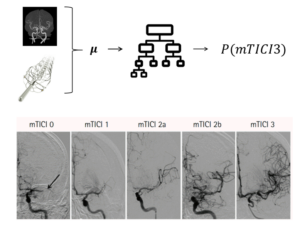

Period:
–
PI:
Participants:
Funding entity:
Acute Ischemic Stroke (AIS), the blockage of brain blood flow due to a thrombus, is an urgent condition and a major cause of death and disability. In the last decade, endovascular thrombectomy (EVT) has greatly improved AIS treatment. EVT is a fast and safe technique based on removing the thrombus (and restoring blood flow) using endovascular devices. Still, a large number of EVT patients remain disabled, or even die, after the intervention.
To maximize patient recovery, complete flow restoration needs to be achieved on the first attempt. This makes surgical planning in EVT crucial, but scarcity of time and information leads to non-optimized interventions with current success rates (of first attempt complete flow restoration) as low as 25%. Because of this, there has been a surge of Big Data derived machine learning models, aiming to predict EVT success from pre-operative data. Despite accurate, these models lack interpretability, posing important barriers for their clinical use.
Multiphysics (thrombus-blood-vessel-device interaction) plays a key role in EVT. Computational Mechanics models provide accurate and interpretable predictions, as they use physical quantities as input and output data. Yet, these models require extensive time for 1) running the simulation and 2) analysing the results. Recently, the combination of computational mechanics models with interpretable machine learning (IML) has shown the potential of providing fast surrogates for both the simulation and the analysis of the results.
MECA-ICTUS aims to build an IML predictor of EVT success. To do so, we will work on developing an open-source computational solid mechanics framework to model EVT and on training an IML from a large dataset of computational simulations. The theoretical and computational developments of MECA-ICTUS will set a first milestone towards the development of a decision-support tool for optimizing EVT interventions, thus reducing mortality and morbidity in the future.


